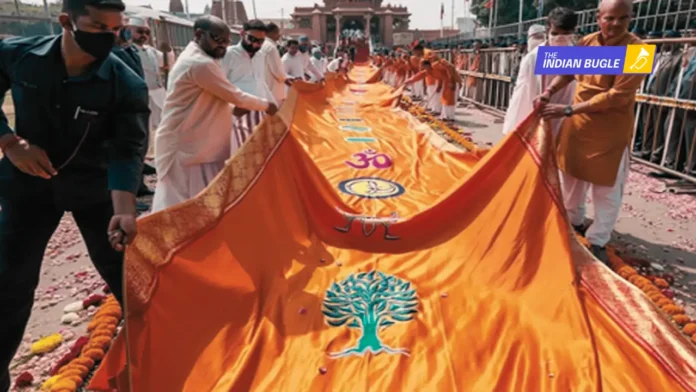The Sacred Flag That Completes the Temple
The Dharma Dhwaj flying above the Ram Temple in Ayodhya is more than a saffron flag—it marks the spiritual completion of the temple and symbolizes the establishment of Ram Rajya. In Hindu tradition, a temple is considered fully “alive” only when the sacred flag is raised on the shikhara.
The hoisting of this flag at the Ram Mandir became a civilisational moment for millions, representing devotion, sacrifice, victory of truth, and revival of ancient heritage.
What Exactly Is the Dharma Dhwaj?
The Dharma Dhwaj (धर्म ध्वज) is the official religious flag installed atop the Shri Ram Janmabhoomi Temple. It is designed in accordance with:
- Ancient Vedic traditions,
- Hindu temple architectural guidelines,
- And modern engineering for safety and longevity.
It carries powerful symbols directly related to Lord Ram, Suryavansh heritage, and the principles of dharma.
Specifications of the Ram Temple Dharma Dhwaj
1. Dimensions
The Dharma Dhwaj is crafted in a right-angled triangular shape, a style historically used on Hindu temples. Its approximate dimensions are:
- Length: 22 feet
- Width/Height (triangle side): 11 feet
These proportions allow the flag to appear majestic and balanced when viewed from afar.
2. Weight
Despite its large size, the flag weighs only a few kilograms. The lightweight design ensures:
- Smooth movement in high winds
- Minimal load on the mast
- Long-term durability
3. Shikhara & Dhwaj Mast Height
- Temple Shikhara Height: about 161 feet
- Dhwaj Mast Height: around 42 feet, mounted at the uppermost part of the shikhara
The mast is specifically engineered to support such a large flag safely.
4. Engineering & Rotation Mechanism
The Dharma Dhwaj system includes:
- A 360-degree rotating chamber
- High-precision ball bearings
- A wind-resistant support system
- Mechanised hoisting setup
This ensures the flag can freely rotate with the wind and prevents tangling or tearing.
Fabric Used in the Dharma Dhwaj
One of the most impressive aspects of the Ram Temple’s Dharma Dhwaj is the advanced fabric used to create it.
1. Parachute-Grade Fabric
The flag is crafted from parachute-grade material, the same quality used in:
- High-speed parachutes
- Military-grade aerial fabric
- Extreme weather gear
Why This Fabric Was Chosen?
Because it is:
- Extremely strong
- Tear-resistant
- Weather-proof
- Lightweight despite its size
- UV-resistant, preventing fading
Ayodhya experiences extreme summers, winter fog, dust storms, and occasional strong winds. Therefore, the flag must withstand harsh environmental conditions without tearing or losing colour.
Design Symbols: Meaning of Each Sacred Mark
The Dharma Dhwaj carries three key sacred symbols, each deeply rooted in Hindu scriptures and Ayodhya’s tradition.
1. The Saffron Colour (Bhagwa)
Saffron represents:
- Renunciation
- Sacrifice
- Purity
- Courage
- Knowledge
It reflects the life and character of Lord Ram, who stood for righteousness above personal comfort.
2. The Sun (Surya)
The Sun symbol on the flag signifies:
- Light over darkness
- Knowledge over ignorance
- Victory of truth
- Lord Ram’s lineage as a Suryavanshi
It is a tribute to the cosmic energy and the royal ancestry of Shri Ram.
3. The Om (ॐ)
Om is the primordial sound of creation. On the Dharma Dhwaj, it signifies:
- Divine vibration
- Spiritual awakening
- Cosmic unity
- Presence of sacred energy in the temple
4. The Kovidar (Kovidara) Tree
The Kovidar tree symbolises:
- Shelter
- Compassion
- Protection
- A king’s duty is to stand in hardship while giving comfort to his people
This reflects Ram Rajya, a system where the ruler carries responsibility, and the people receive protection.
Ritual Importance of the Dharma Dhwaj
1. Marks the Completion of the Temple
In Hindu architecture, a temple is spiritually “complete” only after the dhwaj is installed.
For the Ram Temple, the flag becoming active signifies:
- Divine presence
- Activation of spiritual energy
- Completion of rituals
- Opening of blessings for devotees
2. Symbol of Ram Rajya
The Dharma Dhwaj represents:
- Truth
- Justice
- Equality
- Protection of the weak
- Victory of dharma
These are principles associated with Lord Ram’s rule.
3. A Symbol of Unity
The flag is also seen as a unifying icon, marking:
- Cultural awakening
- Social harmony
- Shared heritage across communities
It stands as a reminder of India’s civilisational depth and unity in diversity.
How the Flag Is Raised and Maintained
The Dharma Dhwaj is hoisted through a mechanised system that gently lifts the flag to the top of the mast.
The rotating mechanism ensures the flag never twists or tightens around the pole.
Maintenance Includes:
- Regular inspection
- Replacement when the fabric wears out
- Respectful retirement following religious guidelines
Just like a national flag, a temple dhwaj is treated with deep reverence.
Why the Dharma Dhwaj Matters Today
For modern devotees, the Dharma Dhwaj symbolizes:
1. Spiritual Strength
A sign that Shri Ram’s blessings and principles guide the land.
2. Heritage and Identity
A revival of ancient temple traditions rarely practiced today.
3. Blend of Tradition & Technology
The union of Vedic symbolism with modern engineering and fabric science.
4. Civilisational Pride
It represents the culmination of centuries of devotion and cultural resilience.
The Dharma Dhwaj of the Ayodhya Ram Temple is a powerful combination of ancient symbolism and modern craftsmanship.
Its saffron colour, sacred symbols, unique fabric, and magnificent height reflect:
- Devotion
- Strength
- Purity
- And the timeless values of Shri Ram
More than a flag, it stands as a message to the world—dharma always rises, truth always returns, and heritage always shines again.
